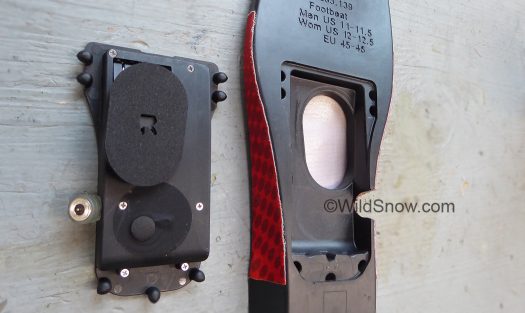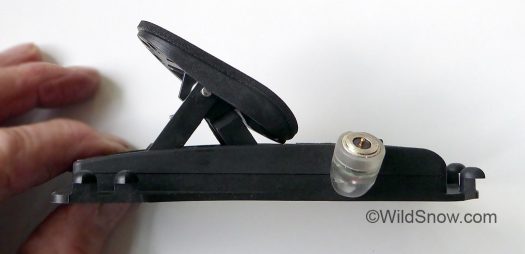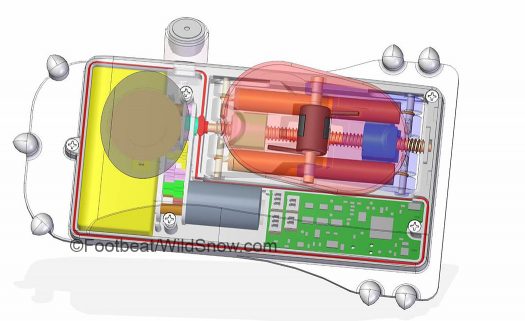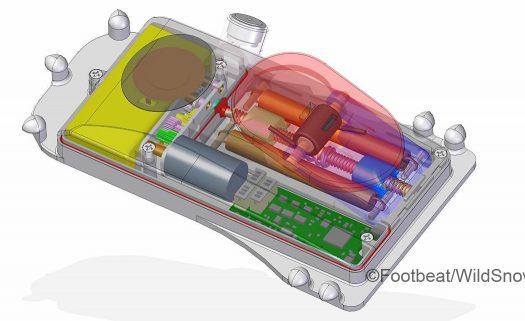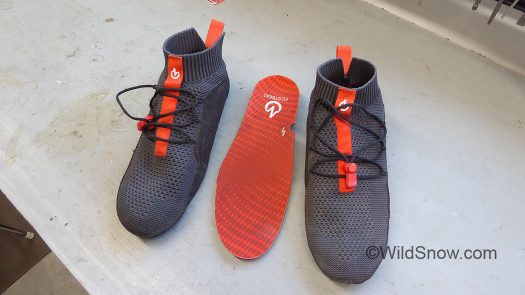
Footbeat is a mechanized insole that’s worn with a special shoe. It’s a foot massager with the express purpose of increasing blood circulation.
Sometimes, a technical innovation comes along that really works. Something that removes discomfort and pain from your life, and perhaps even helps you heal. While perhaps not on the level of the discovery of antibiotics, I have to give the Footbeat foot massager a 10 out of 10 for effective medical invention. Lisa and I have now extensively tested this device. From everything to preventing leg cramps during automobile travel, to mitigating stiffness in the legs and feet after exercise, Footbeat in my opinion is amazing. Both of us are addicted.
The concept is simple. Increase blood flow in your feet and legs while you’re inactive — benefits of this being numerous. To mention a few skier type things this can possibly help mitigate or heal: plantar fasciitis; athletic recovery time; leg cramps; venous insufficiency; restless leg. (Between Lisa and I we have every one of those issues — we’re the perfect testers!). Further, the rhythmic massage of Footbeat is downright relaxing. Use for no other reason than kicking back with benefits.
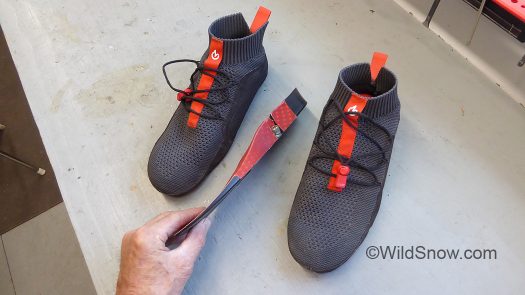
Footbeat insole is somewhat thick, to allow room for machinery. Supplied “moc”
shoe allows for this.
Turns out your foot has an area of blood flow (plantar venous plexus, the “foot pump”) that’s easily influenced, e.g. “pumped” when you walk, thus pushing blood back up to your heart. But the venous plexus doesn’t operate when you’re inactive. (Clearly, yet another downside of the sedentary lifestyle.)
The genius of Footbeat is simplicity and miniaturization. In a small package, it provides provides a compact battery-operated mechanical masseuse that pushes gently against the venous plexus under your arch, in turn enhancing your entire lower body blood flow. The device is built into a fairly conventional appearing insole in a dedicated shoe supplied with the device. A spring loaded platform rises and presses rhythmically on the bottom of your foot about every 35 seconds with about 20 pounds of force.
Other devices exist that operate on similar principles, but they’re unwieldy and expensive. Design philosophy of Footbeat is to apply the same proven medical principles but via a micro mobile device. The appeal is broad. The benefits huge.
“Footbeat has so many uses, with so many benefits, for so many people,” says Mark Joseph, Footbeat’s Director of Design Engineering (he’s the person behind miniaturizing the product and fitting it into a shoe). “Everyone from a pregnant woman to a long haul truck driver. Really, just about anyone who could benefit from enhanced circulation and spends time off their feet.”
Yes, in my opinion that includes specific things we as ski tourers might experience. Such as recovery time after a day in the mountains, healing from knee surgery, or that international flight when fighting the possibility of blood clots in your legs is an ever present concern.
Setting up Footbeat is easy. They come in a nicely designed and easily opened box. Hook up the insoles to the provided charger for a while, then insert in the “moc” shoes designed to snug them under your feet.
Downside here is while you could conceivably use the Footbeat insole in footwear such as an athletic shoe, doing so is not recommended. They’re a bit oversized, and need the moc to compress the Footbeat against the bottom of your foot. You’ll thus find yourself swapping shoes now and then. Not a big deal at home, but inconvenient while traveling as the moc is not a walking shoe, and according to Footbeat should not be used outdoors.
Documentation says the device senses you are walking or running and pauses, then resumes when you’re off your feet. I’d still get pulses now and then while walking or standing. Forcing the pump frame (see photos) to fight against body weight couldn’t be good. Thus, I’d think for anything but a short jaunt to the fridge, best to simply turn off Footbeat before going ambulatory.
Beyond how well they actually do their blood supply thing, my favorite thing about Footbeat is the simplicity of the remote control. I get so tired of overly complex control schemes. Our microwave comes to mind, or the classic TV remote with hundreds of settings that can cause even a rocket scientists to use his remote as a projectile. Footbeat wireless remote does three things: pairing of the wireless signal, on, and off. Yep, that’s it, something with just an on-off switch! I’d imagine the smartphone app is coming — that’ll be nice so long as the temptation for complexity doesn’t intrude. The addition of a session timer would be nice, but that’s about it.
Note that these are mechanical devices and they do make noise. You or fellow passengers would not notice the sound during an airline flight, but you wouldn’t want the Footbeat operating in a quiet public space. Moreover, I found the intermittent noise made sleeping difficult with them switched on. I don’t think the noise would outweigh Footbeat’s benefit for most people, but it’s something you should evaluate immediately if you purchase a set.
Real world testing: Lisa and I identified a few obvious physical problems that seemed perfect for the Footbeat solution. In Lisa’s case, she’s been getting severe restless-leg and cramps while we do our 45 minute drive between WildSnow Field HQ and home base. Result? Her problem was entirely eliminated. Stick a fork in it. Done. In my case, I’ve got a lot of issues with a severely arthritic fused ankle and subsequent inflammation in the associated knee caused by my compromised gait. Sitting makes it all worse. Footbeat clearly mitigated the effects of sitting, more, I’m finding that using the device while relaxing (watching movies and reading) seems to provide an obvious anti inflammatory effect to the entirety of my legs and feet.
Like most medical devices, Footbeat is not inexpensive. It’s around the price of a late model ski touring binding set. Use the bindings to wear out your legs. Use Footbeat to recover. Purchase unfortunately does not come with a 30 day satisfaction guarantee if the box seal is broken (though I wonder if that’s really true, due to this being mail order?). Time your buy for when you’ll be needing more recovery than usual, or spending more time seated than is normal. Test them yourself. I predict you’ll be satisfied.
At this time Footbeat appears to only be available on the Footbeat.com website
(Disclosure: Footbeat technical wizard Mark Joseph and I are acquaintances who go way back to youthful days in Aspen. Lisa and I had a chance encounter with Mark during a hut trip last winter (during which I developed plantar fasciitis). Mark mentioned he was helping develop Footbeat, and I immediately suggested we do some WildSnow coverage as it sounded so appropriate for beat up ski mountaineers such as ourselves. We have no financial or other business association with Footbeat, and while knowing Mark, I wrote and published this review as an impartial take. We received loaner product for testing and review.)
WildSnow.com publisher emeritus and founder Lou (Louis Dawson) has a 50+ years career in climbing, backcountry skiing and ski mountaineering. He was the first person in history to ski down all 54 Colorado 14,000-foot peaks, has authored numerous books about about backcountry skiing, and has skied from the summit of Denali in Alaska, North America’s highest mountain.

